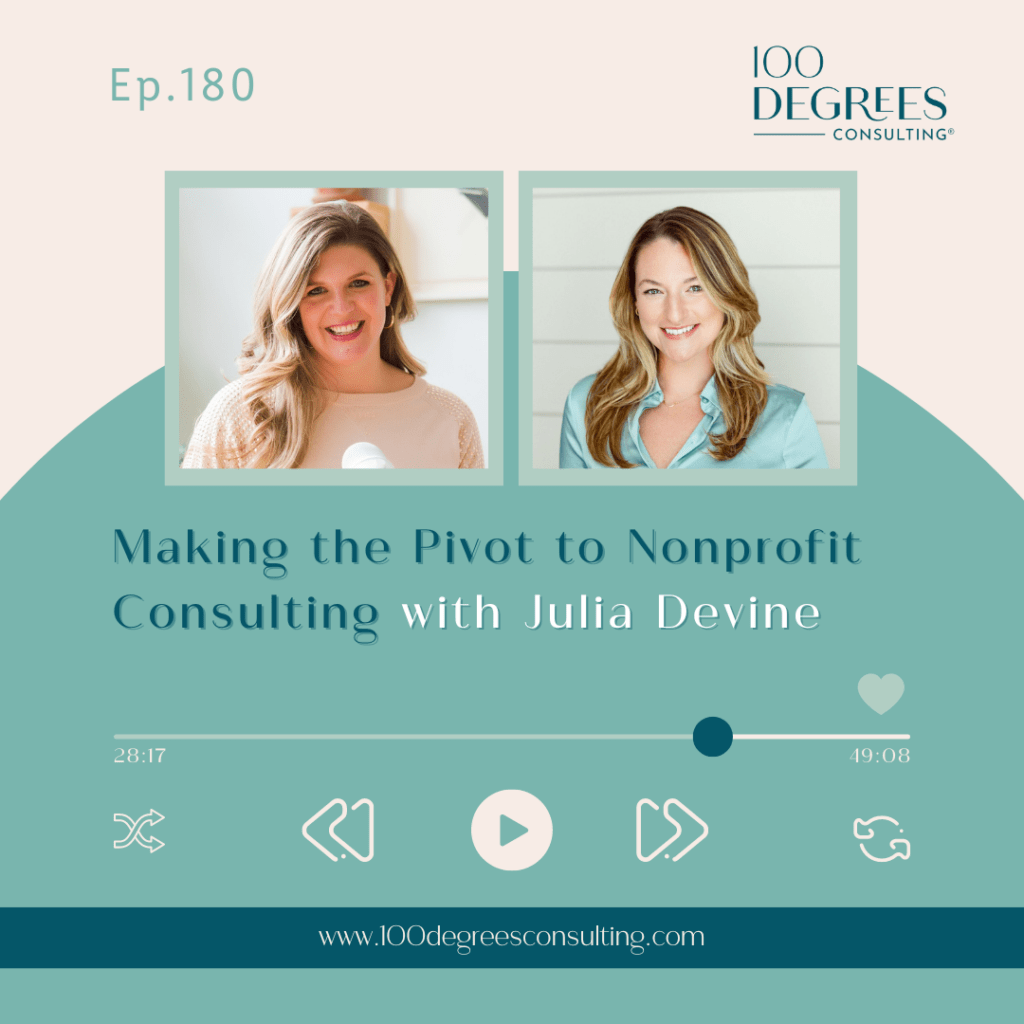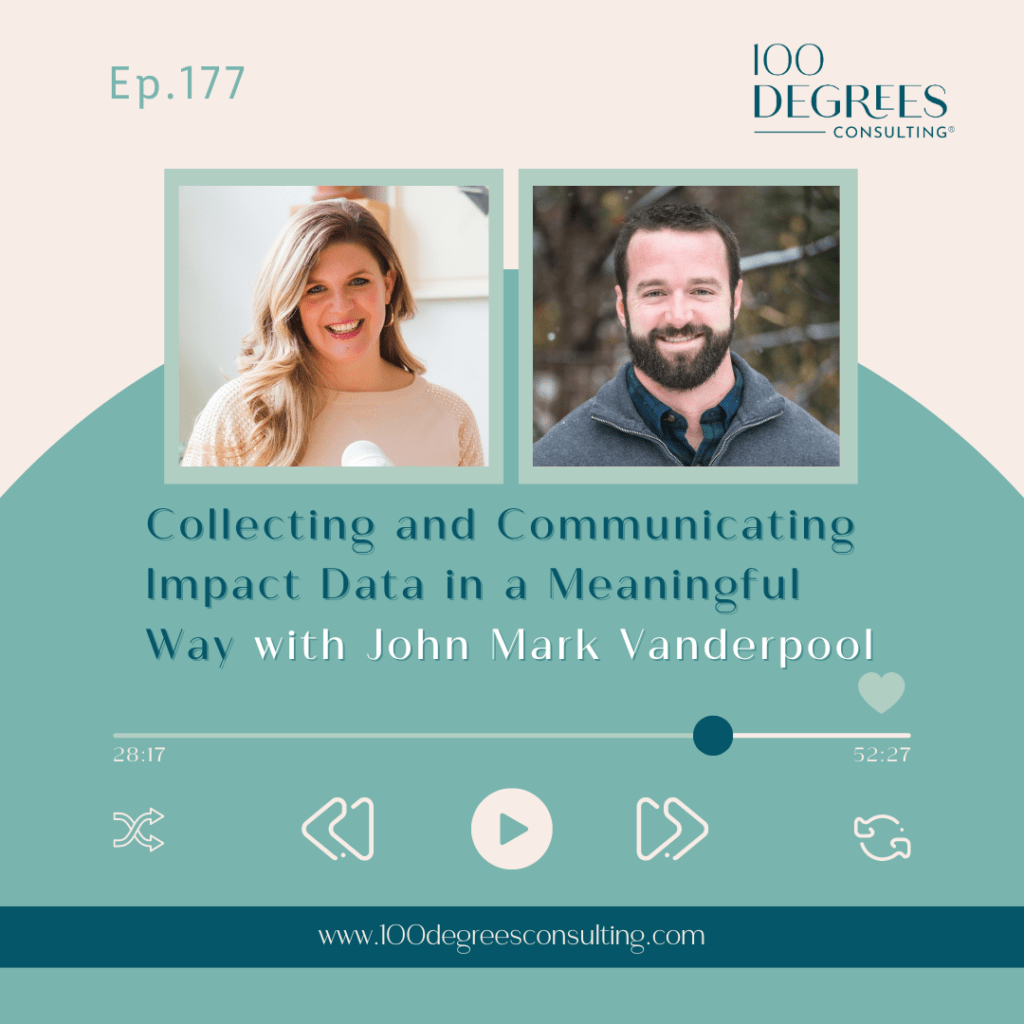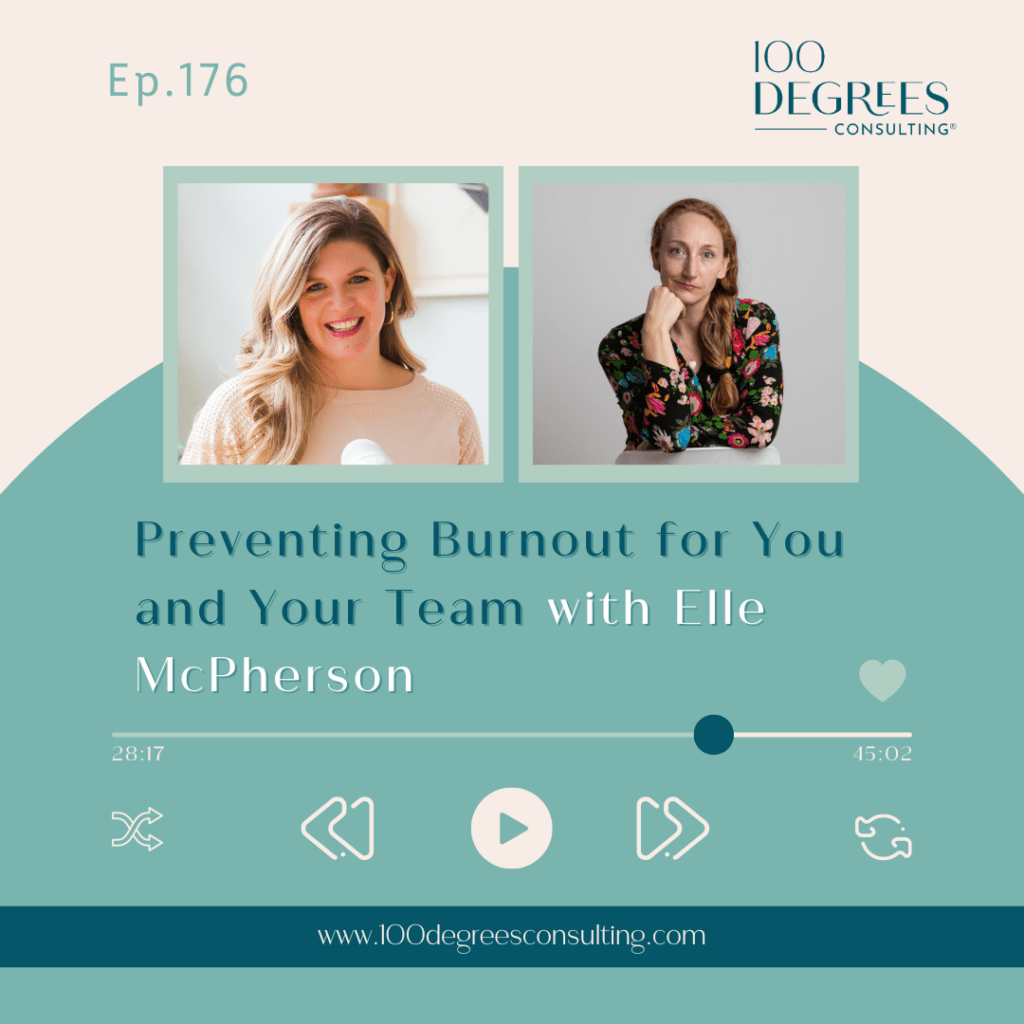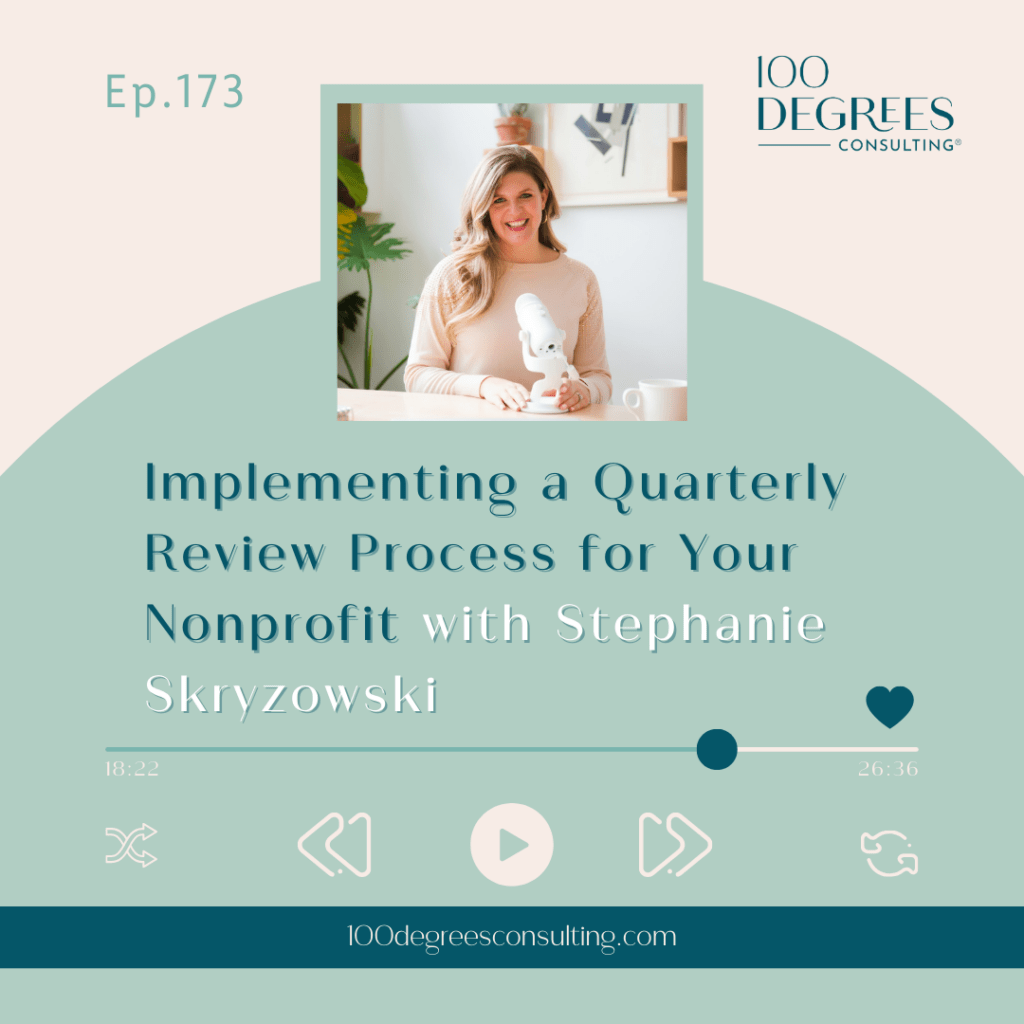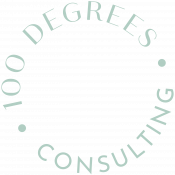Transcript Episode 120 – Building Lasting Corporate Partnerships with Eliza Pesuit on The Prosperous Nonprofit
Stephanie Skryzowski: [00:00:00] Hey there. If you’re looking for the 100 degrees of entrepreneurship podcast, you’re in the right place after a hundred amazing episodes, we’re changing things up to serve you the most inspiring content in a fresh new way. Thanks for being here and keep listening.
Welcome to the prosperous nonprofit, the podcast for leaders who are building financially sustainable and impactful nonprofits and changing the world. I’m Stephanie Kowski, a Chief financial Officer and founder and c e o of 100 Degrees Consulting. My personal mission is to empower leaders to better understand their numbers, to grow their impact and their income.
On this show, we talk to people who are leading the nonprofit sector in new, innovative, disruptive, and entrepreneurial ways, creating organizations that fuel their lives, their hearts, and their communities. Let’s dive in.[00:01:00]
Hey everybody. Welcome back to the show. I had such a good conversation today with Eliza Pasu. She is the founding executive director of an organization called Global Glimpse, and we’ve been working together for almost six years, believe it or not, and she kind of blew my mind. We were talking about corporate partnerships today.
And I think the way that she’s approaching corporate partnerships is so innovative and so different than what a lot of organizations are doing. And she’s really in this for the long game, and Eliza does not come from a background where she has a ton of corporate connections and she doesn’t have a board with necessarily a ton of corporate connections, but she has really put together a sort of strategy and a.
Process for building corporate partnerships that are so aligned with the mission and the vision of her organization that have resulted in millions upon millions upon millions of [00:02:00] dollars in support for global glimpse. And I think this is just really, really special about Eliza and about the work that she does over a global glimpse.
So, I feel like I walked away with so many gems. I’m excited for you to hear them as well. So let me tell you a little bit about Eliza, and I know you’re gonna get even more excited to go ahead and listen to this episode. So, Eliza Pursuit is the founding Executive Director of Global Glimpse, a nonprofit organization that works to bridge divides and empower young people to lead with empathy and global perspective.
She’s passionate about connecting people from different backgrounds through shared experience, and she believes deeply in the importance. Of providing young people from all backgrounds with access to educational opportunities to broaden their perspective and build empathy and agency. Under Eliza’s leadership, global Glimpse has grown more than tenfold and expanded to serve over a thousand students annually, across a hundred US public high schools and youth development organizations.[00:03:00]
Global Glimpse is the only travel and leadership organization in the US serving majority, low income and underrepresented students at scale. And Eliza has built an incredibly talented, diverse. Team and board and position the organization to thrive coming out of the pandemic and like side note for me, I can attest to that.
I have worked with many of her team members over the years and they’re all absolutely phenomenal. She’s built powerful funding partnerships with high profile companies. Listen to this, including United Airlines, Expedia, snap, Inc. And Away like the fancy suitcases that are transforming the travel industry.
And putting equity and access at the forefront. Eliza’s bilingual and Spanish and English, and has lived and worked across Latin America and led global glimpses work in communities across the US for over a decade. She graduated magna cum laude from the University of Massachusetts Amherst, and has received awards for her work from the Edwin Gold Foundation and the Jefferson Foundation.
When not at work, you [00:04:00] can find her watercolor painting going on, outdoor adventures with her partner, 15 year old son and young daughter, gardening, cooking and volunteering with community organizations. So basically, Eliza is a rockstar and she just has so much wisdom to share with us today, and I’m especially excited for you to hear all about the way that she has strategically built these corporate partnerships that I think is just really unique and just absolutely brilliant.
So, I will stop talking now and let’s get right to the interview with Eliza.
All right. Hey everybody. Welcome back to the show. I am so excited to be here, um, with Eliza Pursuit. Eliza, welcome.
Eliza_Pesuit: Thanks so much, Stephanie. We’ve been working behind the scenes for so many years, so it’s such a joy to have, you know, upfront and out there strategic conversations with you.
Stephanie Skryzowski: I [00:05:00] know, I know.
You’re right. We’re always like talking about the numbers and the giant budget workbooks and all that good stuff. So this is, this will be a great conversation. So I would love for you to kind of start with what do you do, what, tell us about the organization that you work with and how’d you get to where you
Eliza_Pesuit: are now?
Oh man. Well, that could take us, uh, week and we need a lot of wine, but, but we’ll, we’ll do our best. Um, so I’m the founding Executive Director of Global Glimpse. We are a innovative, um, creative, pretty entrepreneurial, I would say, nonprofit organization. And we work to make transformative international travel leadership and global learning opportunities accessible to high school students from all backgrounds.
I have been doing this work, my life’s work for going on 15 years now. Um, literally feels like yesterday that I was building our first programs in Central [00:06:00] America and then our first high school partnerships, and then our first corporate partnerships and a lot of firsts. And I think that’s really the ethos of global glimpse we make first.
Opportunities possible for young people that set them on a path, um, to greater perspective, um, agency and opportunity as well as responsibility for the role that they can play in their lives and their communities and their families in this country and our world in creating ripples of change.
Stephanie Skryzowski: Awesome.
Thank you. I love the mission of Global Glimpse, and obviously we’ve worked together for a while and travel is also a passion of mine, and so I’ve just seen the impact that that Global Glimpse has had. I would imagine that, you know, 2020 through a bit of a wrench into your work since your entire organization is, I mean, not entirely, but like.
One of the core activities is travel. Um, and [00:07:00] so as a leader, you really had to pivot. And I feel like there are a couple roads that global glimpse could have gone down. And one is like, all right, well we’re shutting our doors. There’s no more because we can’t travel. Or there’s a road. You did go down and I feel like.
It takes a really innovative, um, strategic leader to make some of the choices that you made. So tell us about, tell us about your pivot and maybe like, I don’t know, some of how you were feeling as a leader during that time. Hmm.
Eliza_Pesuit: Thank you for, for bringing that one up. Um, 2020 was one of the most, Challenging periods of anyone’s life.
Um, and to work at, you know, the intersection of travel and education at that moment, um, made things much harder in many ways. But I also deeply believe that when we are called and we have. Purpose. Um, and we need to [00:08:00] act. Uh, we’re given great opportunity to step up. And during that time, my father was also terminally ill and I was, um, pregnant with my first child.
So, You know, bring it, bring it on. Um, when it rains, it pours. Um, but one thing my dad, um, mahi rest in peace used to say was, to whom much is given, much is expected. And it’s with that lens that I really moved through the very challenging, um, decisions of 2020. And so in March, You know, when the world changed, we realized very quickly that not only was there no way that we could run in-person programming, um, in the summer of 2020, we were gearing up to serve well over a thousand students, a hundred educators on 60 different international experiences, um, that summer.
But we were looking at revenue loss in the order of 2.5 million, more than half of our budget. Um, and we operate on a cyclical. [00:09:00] Cycle each year. Our students travel during the summer, given they’re all in school and we can’t run programs at another time of the year. So basically we had to be making decisions, um, not just for the next couple of months, but for a full calendar year and beyond.
And we did that very well. And I think a couple of key ingredients that guided our decision making at that time were integrity, that we were, um, Deeply operating in integrity with our values as an organization. Um, that we were transparent with all of the stakeholders that our decisions impacted from our team to our board, to our donors and supporters, and, um, Critically to our students and families and international partners.
And so, um, you know. When we first sat down as an executive team and really understood the magnitude of the decisions we were going to be making. It was with that mindset. And we sort of set up [00:10:00] a couple of guiding principles that we put every decision through. Um, does this decision honor our values? Does this decision take care of all of our stakeholders to.
You know, the extent that we possibly can given the challenges of the time. Um, and so we did end up making the very tough decision to cut our team from 30 full-time and 50 seasonal down to eight. And we did that very early on before anyone else in the travel sector had made a call. To fully cancel our postpone programs because we knew if we didn’t, we wouldn’t be able to take care of people in line with our values.
And making that decision very early actually positioned us better to communicate with transparency and clarity to all of our stakeholders, which then helped our reputation, which helped build trust and allowed us to move through, um, you know, such a challenging period with. A lot of grace. [00:11:00] And as a result, you know, of doing that early on, doing that quickly, doing that in line with our values, we were able to actually pivot strategically very quickly as well and ensure that we built programming, um, virtually that.
Served students and educators at a time when everyone else was scrambling. So we were actually able to very quickly translate the best of global glimpse, our globalization program, our intercultural programming, our youth leadership programming into a virtual space, and to meet students where they were bringing the world into their living rooms, allowing teachers to plug in global education curriculum at a time when they were just desperate for any kind of respite and support.
And so we certainly couldn’t run global glimpse in the way that we had ever understood or imagined it before. But quickly moving to translate our programs into a virtual space and really diving into, um, during that time the kind [00:12:00] of organization that we wanted to be when we emerged really, really pushed us to evaluate, um, and, you know, tackle things that had always sort of, Been left behind, right, that we were moving too fast.
We needed to fill this position, we needed to make this higher, We needed to build this structure curriculum or whatever, because, you know, um, students were coming and it was imminent. We didn’t have that anymore in the way that we are operating, We had to be creating from scratch in a lot of ways, and really looking at the organization we wanted to become in the world of the future.
Stephanie Skryzowski: Yeah. Um, I just like look at what y’all sort of had to do during this time and just admire you so much. And I think it’s just a beautiful example of this, um, intersection of being really mission focused and still figuring out how do we serve our students and [00:13:00] our teachers during this challenging time, while also making really smart.
Really savvy business decisions and I just really like, I really look up to you for what, for your leadership and, and the organization and what y’all, what y’all did. Because I think it really is this beautiful mix of focusing on the impact and the people that you serve while also like, okay, we gotta survive.
So like, what business decisions do we need to make? And thinking outside of that, like, this is how we’ve always done it box. Cuz it seems like you really did. Innovate during that time. And yes, it was sort of like forced initially. Like you had to, you had to do that. But again, I think there were a couple different paths you could have gone down.
Like you didn’t have to do that, right? Like there are paths that you could have gone down. So I just, yeah, I really, I really look up to you for what y’all did in the way that you innovated, um, during that time. So another thing that I wanted to talk about was really like revenue diversity. I know that Global Glimpse has [00:14:00] a pretty diverse like set of revenue and you’ve also built some pretty amazing partnerships with big name brands that support your mission in really impactful ways.
And so I would love to hear, yeah, some more thoughts on having diverse revenue streams and you know how you have cultivated this over time. It’s
Eliza_Pesuit: a, it’s a great question. Um, I’ll just start by saying there’s no silver bullet. It’s diligence and relationships and, um, you know, a lot of time and sort of a belief that the impossible is possible and persevering.
I think that, um, Anyone who works in fundraising or an entrepreneurship or any kind of major innovative business endeavor knows that. But I think at Global Glimpse from the beginning, we’ve really had a mission driven, business savvy mindset, and that is one of our core organizational values and it’s integrated across the organization.
And I feel [00:15:00] it’s my job as a leader to. Position, support, educate, empower every single person in the organization to be positioned to make the best decisions for the organization strategically, financially, at whatever level they’re operating. Um, and. Even if you’re not working in a direct revenue generating role, um, your work supports us to generate revenue.
So if you’re working on the international teams and you’re running programs and you’re running phenomenal programs, and students are coming back and talking to their families and they’re talking to. They’re community leaders and they’re talking to their principals. That has a ripple effect that leads to additional applicant applicants, that leads to new school partnerships, that leads to parents getting involved as donors after their students go through the program.
So everyone in the organization is revenue generating as kind of one pillar, I’d say to that strategy. And then secondly, [00:16:00] um, we have always looked at our organization as being both, um, you know, Having both earned and contributed revenue. And so on the earned side, we operate on a sliding scale. It’s a pretty unique model.
You can see it in universities, which are nonprofits. But I haven’t been exposed to any other youth serving organization in the high school space that operates on a sliding scale. Uh, you say see lots of organizations that serve more of an affluent clientele that are very expensive in the college preparatory space.
Um, you see lots of organizations that serve. More of an underserved population that provide programming mostly free of cost. We actually. Believe that every student can and should contribute to their experience. And what they contribute is based on their, you know, the means of their family and the community situation that they’re in.
And so we provide scholarships on a sliding scale in order to calculate, uh, what a. You know, [00:17:00] what scholarship student should receive. We look at the family income, a 10 40 tax form, um, or pay stubs if a family’s undocumented or some other form of documentation showing us that students need. And we do that for accountability with our donors and partners.
We wanna ensure that their resources are allocated to the students that most need them. And then we also look at, um, The economic situation in the community where the student goes to school, so the free introduced lunch percentage of the school. We know students in schools that have higher free introduced lunch percentage have less ability to fundraise from their community.
And so we also take that into account as well as dependents, right? Because if a family has six kids and their family income is a hundred thousand dollars, it’s very different than if they have one. So all of those pieces go into calculating scholarships for us. But even our full scholarship students fundraise a minimum of $500, and they do that over the 10 months leading up to their travel experience, and they make four payments towards [00:18:00] that $500.
And so there’s a sense of. Agency, their family’s involved, their community’s involved, their church is involved, their teachers are involved, and they contribute to that experience, which means they have greater ownership of that experience. Right. We really believe that everything, um, you know, nothing is given.
Everything is earned. And, um, no matter where you come from, you have the ability to create opportunity for yourself and to generate resources and invest in things that are important for you and for your family and your community. Um, on the contributed side, we. Have, as you said, very diverse revenue streams.
We work with corporate supporters, we work with institutional foundation supporters, and we work with individuals and we have growth opportunities in all of these. Um, I feel figured out some, um, I think I. Really important guideposts, especially in the corporate partnership space. And we’ve had success with institutional and foundation giving to a certain extent, but not [00:19:00] wild success.
Um, I think I have a lot of growth opportunity with individuals and it’s an area I really haven’t spent a huge amount of time, so I’m excited to be spending more of my time, um, in that area now. But on the corporate side, um, I think a couple of lessons I’ll pass on. Um, and I’ll caveat that by saying five years ago, this was completely a foreign space to me.
Like I had no idea mm-hmm. How anybody possibly ever did this. Mm-hmm. I would see, you know, big Brothers, big Sisters and Bank of America and I’d go, oh my. Like, what? How did they do that? What, five, half a million dollars? Like, that’s mind boggling. Now that I’m sitting on the other side of the table, um, I think there’s a lot of mystery and sort of fog around how you build corporate partnerships.
Um, and there’s even people trying to make money, you know, with all kinds of courses and conferences on this. Um mm-hmm And what it really boils down to in my [00:20:00] experience, is finding companies where their business needs. And values align with your organizational impact. Mm-hmm. And so at Global Glimpse, we’ve been able to do that really effectively in the travel space as well as with a couple of other, um, companies.
And so I’ll give you the case study of, um, United Airlines, for example. United has. An in-kind product that doesn’t cost them very much to provide, that has a tremendous impact on our budget. Um, and as Stephanie knows, a very complex impact on our accounting, but we won’t get into that. Yes. Um, but United, you know, really did not have a philanthropic strategy that aligned with their, um, Business values and business needs prior to, you know, 2018.
And so companies are in the process of figuring this out. And as a nonprofit you can actually help them to [00:21:00] build authentic stories out in the world and engagement opportunities for their employees that are in line with their values and support their business needs. Um, we’ve been able to do that successfully with United.
We’ve been able to do it with a way, um, you know, the Sexy Suitcase brand you see if you travel anywhere these days. Mm-hmm. Um, and we’re now building partnerships with TripActions and a number of, um, other companies that, that are big in the travel space. And I think, you know, the, the way that I think about corporate partnerships really falls into three buckets.
It’s what story do they wanna tell in the world? And you need to ask questions to figure that out. Don’t, you can’t assume. Some companies are very public with their philanthropy. They want a bunch of pr, they want impact stories, they want flashy stuff. Other companies are very quiet, but the, you know, c e o or founder may have allocated a certain portion of profit, um, to philanthropic work.
And [00:22:00] it could be, you know, structured into their, the way that they iPod and their financial, you know, operations and. You know, you might not have to do any storytelling or external, external facing work. They might care much more about en engaging their employees and finding ways to do that, um, that are really powerful and bite sized.
Um, and then every company wants to see impact. They wanna see that when they’re contributing dollars, especially large sums of dollars, they’re going directly to have an impact in the communities and the ways that they care about. Um, and so, You know, I think structuring corporate partnerships in a way that, um, really allows you to look into each of those areas and quantifies how much time it takes you to manage that and, you know, effectively steward that partnership.
So we always build in your time when you make a proposal [00:23:00] eventually. Um, and then really looking at like, who is a decision maker? And how are you stewarding them? Mm-hmm. And what do they care about? So I live on LinkedIn. My development team lives on LinkedIn. Increasingly, I’m speaking more publicly on LinkedIn, so I’ll write an article about something that, that I care about that’s aligned with, you know, something we’re, we’re facing a global glimpse.
Actually wrote a great article, um, about world building, world changing partnerships, um, across sectors that you can check out. Um, on my LinkedIn and I, um, I’m always targeting people on LinkedIn. I don’t mean that in like a negative way. I’m not, I’m not targeting them for anything negative, but I’m watching them.
Right? So, um, we just are in the process of launching a partnership with Expedia. Now, I had been watching Expedia’s corporate social responsibility strategy for a year and a half before I reached out because I knew that we would be perfectly primed at the right time [00:24:00] coming out of the pandemic. To pitch them.
And I knew who the right person was when they hired her. And so that kind of strategic, you know, um, evaluation of what a company is doing, what they’re talking about, what their executives are talking about. LinkedIn has great features. Now you can follow key leaders and executives and see what they’re talking about, what they care about.
Um, So that eventually when you do get the right intro or position, the right ask, you have context. You know what they’ve done, you know where they’re going, you know where they’re likely trying to go, and you’re able to position yourself to be the answer to some of the questions or challenges or opportunities that they’re looking at.
Sorry, I ramble. I get really excited about corporate partnerships.
Stephanie Skryzowski: No, like I’m so excited too, because I feel like this is like an untapped goldmine. If listeners were not taking notes, you need to be taking notes because I’ve never heard anybody talking [00:25:00] about using LinkedIn as a strategic tool for nonprofit corporate partnerships.
Like we hear there’s like databases for all the grants and all the like major gifts and all that stuff, but I don’t hear about corporate partnerships a lot. And I hear about LinkedIn all the time in the small bus, like in the entrepreneurial space, it’s like found your, you know, find your partners on LinkedIn or find clients on LinkedIn.
But we’re not talking about finding corporate partnerships for nonprofits on LinkedIn. And that’s freaking genius and I love it. And I love that you are making like your own thought leadership as a nonprofit leader. A priority because you do have an important message, and I love that. It’s like it’s on LinkedIn.
So when you’re making those connections, they’re seeing that you’re telling the story that their company also wants to tell, like that’s really smart. Would you say like, you know, these corporate partnerships, I feel like a lot of nonprofit leaders think well, Somebody I need to have a big, like, I need to have a big name connection.
Like [00:26:00] somebody on my board needs to know somebody else or somebody on my board needs to be working for one of these big companies in order to, to make it. You’re like shaking your head no. Like that’s not, that’s not the case. Let’s dispel that myth.
Eliza_Pesuit: Yes. Yes. Let’s dispel it. Um, so I don’t come from any big networks.
I, I, you know, I didn’t grow up with significant resources or access. I went to public university, close to home. Um, you don’t, you don’t need to have all the flashiness, but you do need to be super strategic. Um, and so United Partnership took me eight years. To build. Mm-hmm. And it start, you know, it was a dream in my mind.
I remember back in 2009, I was sitting on a plane looking at the seat backs and thinking, man, this is the lamest stuff ever. Wouldn’t it be awesome if they had a global glimpse student? It said, United making first travel [00:27:00] experiences possible on the back of the CPACs. And that was kind of my guiding light.
And I was like, I’m, I’m going to, I’m gonna achieve that. I’m gonna make it happen because the way that airlines are doing philanthropy right now doesn’t make sense. It’s not strategic. They can do it better and, and I can help them do it better. Um, and so I think there’s a little bit of like, I don’t know, this is probably the, not an appropriate word, but like you have to be ballsy.
If you’re gonna be working with, with corporate partners and when you get one, it snowballed. It’s a credibility situation. Mm-hmm. So, closing United for us in 2018 at the multi-million dollar level and building, you know, co-branded materials and videos and collateral and aligning ourselves with them, we had that credibility that allowed us to bring in snap.
It allowed us to bring in away, allowed us to bring in TripActions now Expedia. But every step of the way there, it was kind of like, Like little baby [00:28:00] steps. Um, so I met with in, um, first of all, I cold outreach to everybody. Like it’s kind of, um, absurd how much I do it. I do it really strategically, but, but I just, I write people, um, and I write people really authentically and I follow up like 6, 7, 8 times, um, gently after a month, after two months after, six months after a year, because.
People take it super personally and they think they’re being rejected, but everybody has a million things going on. And if you’re an executive, you have 10 million things going on. Um mm-hmm. So to, you know, deal with this little other thing of somebody you don’t know is, you know, last on the totem pole.
And then there comes a moment when they’re having a sort of, what is my purpose moment? And if you’ve been. You know, that little, yeah, tick, tick, tick. You come to mind, or you just happen to hit on a morning when they’re, they don’t, you know, have anything else going on [00:29:00] and they respond. Um, I’m doing that right now with like six different people.
I’m always doing that, and it has never had a ne negative impact, like if they never respond. Horrible. Who cares? Yeah. But eventually, most people do respond in some capacity, and so I was kind of looking at all of the major airlines. I was looking at anybody who was in corporate social responsibility at the airlines, and I got.
To this woman, Maureen McClellan, I’m still in touch with her. She works in government affairs at United still. Um, and she was running their, um, very limited C S R work in the Bay Area. We had coffee. I told her my vision and she was like, well, we don’t do anything like that, but here’s, you know, 10 or $20,000 in certificates that have a whole bunch of regulations that you can’t even use for groups.
But I said, thank you profusely. And I kept building the relationship and she got me to Chicago and then we launched programs in Chicago and. I was able to connect through her and the credibility in the Bay Area to be a part of conversations as they overhold their [00:30:00] whole strategic, um, C S R work. And then they supported our Chicago travel at like $70,000.
That went really well. And then basically they asked me to submit a proposal and I asked for, I like thought about it. Okay, I can ask for the Honda, I can ask for, you know, the civic, I can ask for the bmw and I asked for the Rolls Royce and that’s what they gave me. Yes. Cause to them it, it didn’t matter whether it was half a million dollar in kind or a million dollar in kind, it was, it’s all in kind anyway.
It doesn’t really, really impact their budget. Right. Um, so yeah, my point is like, Always look for a more warm intro. Find your key decision makers, find your key strategic leaders, and then always try for a warm intro if you possibly can. I got to Expedia through a woman who used to run HR at a firm that used to fund us in San Francisco six years ago.
And I’ve just amazing. I’ve stayed in touch with her. I wrote her on LinkedIn and I said, Hey, you know, do you know this [00:31:00] woman? She said, I went to business school with her. I haven’t been in touch with her for years, but I always really loved her. I’d love to catch up with her. Let me see. Boom, intro happened three months later.
We had a major financial commitment, so that is like a very rare occurrence, but the point is like you don’t have to have everything in order. Um, and over time, You get better and better at how you structure it. But the key thing is like, do you offer something that is going to be of tremendous value to that company?
How, why, and then who is gonna be in a position to actually make that decision? Mm-hmm. And I think this is similar, right in like the foundation world, it’s similar. You can get a no from a foundation for years and years and then you get into the right person and boom, there’s a major investment. Um, so it’s, that’s kind of how the world works and we can feel negative about it or, you know, throw a, throw a fit that people don’t respond to our emails.
Um, So we only have the capacity so much ev, [00:32:00] you know, for so much. Every individual only adds that capacity and so you have to really show them where you’re going to add value for them, and you have to get to them in the right way at the right moment.
Stephanie Skryzowski: Have you been spinning your wheels trying to figure out how some nonprofits have three or six months of a cash reserve while you’re barely scraping by to make payroll every two weeks? I’d a venture to guess that one of the reasons you feel overwhelmed and nervous about your cash situation is because you don’t have a forecast.
So I’ve created a free cash forecast template for you. This spreadsheet will help you forecast your cash flow, build an insightful budget, and really help you see into the future of your revenue and expenses. I’ve built the template for you now. All you have to do is use it, gain more clarity into your numbers.
You can make smart decisions today to grow your impact and income tomorrow. Head over to 100 degrees consulting.com/cash [00:33:00] to get your free spreadsheet.
I am like so obsessed with all of this. Because you know how you and I met. It was through a cold email that I sent you that was very authentic. I was like, I love a global glimpse. I wanna support you. Here’s how I can do that. Let’s talk
Eliza_Pesuit: and, and I was like, sounds great. I have a challenge.
Stephanie Skryzowski: Exactly.
That’s how we first met and that’s the how my entire business was built. And then, you know, referrals and people think of you after that and it kind of goes from there. But like my business was built on hundreds of cold emails and you don’t need hundreds of yeses. You need like one Yes. And I, I really don’t think I have heard of anyone talking about this strategy of.
Sending strategic, targeted, cold emails to prospects in the corporate space. I mean, I guess they’re, you know, you’re sort of sending maybe like a cold proposal to a foundation or something, but, but I love the idea of [00:34:00] like using LinkedIn, see who’s connected to who sending the message. And it really is a long game.
And I love that you have the like, tenacity to. Play the long game because again, you don’t need like a hundred yeses. You need like one yes, because that’ll turn into another and another, but um, But it is such a long game and I feel like it’s very easy to give up when we’re looking around us and we’re seeing other organizations like get this big multimillion dollar grant or this big award, and it’s like, well, how’d they do that?
Like you said, it seems like there’s a magic bullet, but there is no magic bullet or silver bullet magic bullet. The magic bullet’s, the blender, right. A magic bullet or silver bullet. Okay. That bullet, there’s no bullet to make things go faster. So I, I just love that you have had the tenacity to play the long game.
I just think about your bold vision of being on that united flight and thinking like global glimpse [00:35:00] needs to be like in this material, in the seat back pockets plus the audacity and sort of the. You know, the determination to go for the big ask and to play that long game and look what it has done for your organization.
Like millions upon millions upon millions of dollars, meaning thousands upon thousands of thousands of students that have been able to have this transformative experience. And so, That is just so inspiring to me and I love it. And I think you gave some really good tips on if anybody, any other nonprofit leaders are listening, like, this is doable.
This is not something that just like happened overnight for you. This is a lot of work that went into it, but it’s stuff that, something that any leader can really, can do.
Eliza_Pesuit: Absolutely. And and I think it’s transitioning the mindset away from like corporate sponsors to corporate partners. We’re not looking for corporate sponsorships.
We’re looking for long-term integrated, sustainable partnerships where we add value for the company. And that means, you know, you’ve [00:36:00] gotta have a team that can support that. So there is a certain size I think you need to be at to work with, um, larger companies. But when we close United, our budget was about 2 million and mm-hmm.
And they committed a million dollars a year. You know, it, it can start small. Um, but. That sort of, um, mindset around how you’re looking to collaborate. And that’s, um, Where you build relationships with the people that are, um, working in that space at the company. And sometimes it’s a dedicated full-time staff.
Sometimes it’s a couple, sometimes it’s a whole department, sometimes it’s the marketing team. But you’re really understanding how you can best serve them. And so that means when they. Need you to quickly pull together a press release. You pull together a press release when they need some images. You pull images when need.
They need a story. When they want to showcase something to executives, you’re, you’ve gotta operate again, this goes back to the mission driven business savvy. You have to operate with [00:37:00] a business forward mindset, and that’s the culture that we have at Global Glimpse. And I think that’s what sets us apart as a corporate partner.
They know that. Mm-hmm. They can call on us and we will be super professional, super responsive, super thorough, and we’ll bring a level of authenticity and integrity in the way that we engage our young people. Which is so, so important. We’re not, um, you know, gonna put our students on display in a way that is in line with our values.
Um, we’re not gonna tokenize our young people in any way. And so there, you’ve gotta stand your ground in, in some ways as well. You have to really build values, um, based partnerships. Otherwise, you know, you’re gonna put yourself in a risky situation overall as an organization or a situation where your program staff aren’t aligned with your development staff, and then you have a whole other set of challenges.
Stephanie Skryzowski: Yes, yes. You almost need to sort of step up and operate like a corporation. So I think that [00:38:00] goes back to, you know, the mission driven, business savvy. I think that’s just such a fantastic sort of mindset and combination and something that I know kind of runs through all of global glimpse and I I love that.
Um, I wanna go back to something that I wrote down that you said earlier that everyone is revenue generating. I’m obsessed with this also because I think it goes along with the transparency that you’re talking about, and I’ve often talked about this as well, like especially when it comes to your numbers, when you’re transparent about your numbers, there’s a greater sense of ownership.
And if people know like. What is the budget? What are we all working towards that they can be a bigger part of that, so they’re gonna be more engaged, whether it’s your board or your staff or whoever. But I would love to hear like how that sort of, um, yeah, how you sort of do that at Global Glimpse. What does transparency look like, agency around your finances, and then sort of leading to that, everyone is revenue and generating mindset.
I just, I love that
Eliza_Pesuit: so [00:39:00] much. Yeah, there, there’s a whole lot here. So let me try to break it down into like bite size pieces. Um, I think one is the budget development process, which, you know, Stephanie, um, we have iterated continue to iterate and improve. So again, we are not perfect. We are always learning in this space.
Um, but really building ownership. For department leads in the budget development process, and then for them to bring in their teams so that everyone is a part of the annual budget development. And when we get to finalizing that budget and board approval, there’s no mystery around it. There’s no mystery around why we’ve made certain decisions to prioritize or deprioritize certain things.
Everyone understands those decisions and that process. Um, and then we reforecast quarterly now, um, and not only do we reforecast, but for example, um, an hour ago we had our [00:40:00] full team standup meeting, which we do weekly, and I took 10 minutes of that to share the reforecast and a summary of our Friday board meeting with the team.
Basically I copied the slides that I developed for the board. And I shared them out with the team so that the team has the same information that the board has. And in my experience, I think there’s a lot of, um, sort of secrecy around boards and around who has access to the board and mm-hmm. Who is, you know, where power sits and so mm-hmm.
I’ve been sort of trying to, as we work within our organization around, um, Kind of breaking down patriarchal systems in our organization. Mm-hmm. And in the sector, um, trying to see where I contribute to that, um, by, you know, purposely or un purposely or accidentally, um, being sort of a bottleneck or a holder of power.
Um, because I am generally the [00:41:00] person that is, you know, I sit on the board. I’m a non-voting member, I’m a part of board meetings. I’m the liaison to the team between the team and the board. And so really creating transparency, um, not only around our finances, but around discussions that are happening on the board and the decisions that need to be made.
Um, so in this reforecast, we’re down about, um, $60,000 from where we had projected on the year, and we’re looking at a net loss on the year of about $180,000. Um, which is not wildly outside of, you know, the tracks. Saying that there is, in transparency, there’s building buy-in to the process so that when decisions need to be made, there’s no surprises, right?
Mm-hmm. And so that is an ongoing process. You don’t get to build buy-in, and then you’re done. You build buy-in to the budget development, and then. Each time that you iterate on that or reforecast or have to make this different decisions, you’re building buy-in, [00:42:00] you’re educating, you’re providing exposure to that.
So that your team is not surprised. We have a similar approach to this in the people operations arena. And this is an area we’ve done a tremendous amount of work actually with, um, a team of diversity equity inclusion consultants over the past three years. And it’s really working to increase transparency around development pathways for each of our team members as well as around compensation, performance, evaluation, reviews, um, so that.
Again, ideally there are no surprises. You know where you are, you know where you stand, you know why, and you know what you can do to get to the next level, whether it’s a title change or a compensation increase. Um, and ideally your training and supporting your managers to be having these conversations in an ongoing way.
So when you get to. Evaluations. There are no surprises there. And when you get to annual [00:43:00] conversations, there are no surprises on how the organization is doing. I e do. We have the resources for significant increases. What is the market we’re operating within? What kind of, um, surplus or net loss are we looking at?
And then where does each individual stand? And, you know, overall, um, how are we benchmarking across the nonprofit sector and outside of the nonprofit sector? So, um, I’m really proud of the work we’ve done in this area. I know there’s a huge amount that we can continue to grow and learn and do in this area.
Um, but I have seen a huge transformation coming out of the pandemic in our organizational culture as a result of more, um, intentional investment at every level around transparency. It’s always been part of our values, but it’s integrated a much higher degree, and I will say that. A big piece of this is having an FTE e [00:44:00] uh, you know, a full-time team member who’s fully dedicated to the people aspect, and we’re actually transitioning her to own more of the budget development process.
And so that’s kind of an interesting piece, right? We don’t have a. A C F O. Um, we don’t have a senior level financial team member. We have a hundred degrees and they’re a great partner in the work and we have a fantastic financial operator, um, who’s growing in his ability. He’s been with us 10 years, but having a, a more senior kind of people person who can really tie together the business and the people is super important.
Stephanie Skryzowski: Yeah. I love that. How transparency is interwoven into like a number of different facets of global glimpse between your financials and your HR and the board? Um, I feel like. I don’t often see that. And I, I often, um, think about and refer to, um, your quarterly [00:45:00] re forecasting and your budgeting process because it is so transparent and so collaborative and department heads are involved who then involve the teams underneath them.
And I think that is really powerful because then everyone really understands the budget. Even if you’re not a finance person. Like we can help you understand so that you can use it and. We’re all sort of working towards those same goals and so this is not something new for y’all. Like you’ve been doing this for years, upon years, upon years.
So like I love that because there is often this sort of curtain when it comes to the financials, when it comes to the board. That was an interesting point you made about the board because, um, Yeah, I’ve been in a lot of different organizations where it’s like, don’t you dare to speak to a board member without like permission or through the c e o or executive director or whatever, like.
Don’t even think about it. They are, you know, they’re up here on this pedestal not to be spoken to ever. [00:46:00] So I love that, the work that you’re doing there. I think that’s really, really important. I really appreciate this whole conversation. And before we wrap us up, I have one more question. What does a prosperous nonprofit look like to you?
Eliza_Pesuit: Ooh, um. I’m sort of visualizing it. We do a lot of visualizing exercises. A prosperous nonprofit is a wonderful place to work that does wonderful work. Um, impactful work in communities in line, um, with its mission. I feel Global Glimpse is a prosperous nonprofit at this moment. Um, Because we have the capacity, which is a privilege to think about, not just how are we doing things, but how can we do them better?
How can we do them better for all of [00:47:00] our stakeholders? Um, and there have been many moments where I did not have the capacity to do that. Our team didn’t have the capacity to do that. We didn’t have the resources to do that. And so I think for whatever reason, the kind of image of the nonprofit sector is this hand to mouth, barely surviving martyr, um, image.
And it doesn’t have to be that way. Yes, there are ways to. Set up, you know, this work and this sector that don’t destroy people. Um, because destroyed people, unhealthy people make unhealthy decisions and create really, you know, problematic and, and negative ripples, um mm-hmm. You know, [00:48:00] in so many ways. So I think a prosperous nonprofit, um, has.
You know, the resources and the support to not operate in that kind of scarcity mindset. And anyone who works in development knows that you have to operate in an abundance mindset. And so as a leader, it’s really, really important to operate in an abundance mindset, even. When you’re going through the toughest times.
And that’s what I would say to myself through the pandemic and what, what I say to myself at any time. I’m feeling really stressed at this point. I am in such a position of privilege as a leader and as someone in power. Um, and, you know, as a white person in this world doing this work. So, um, I think I try, I try to operate with that level of accountability and responsibility, and it comes back to, to whom is, you know, to [00:49:00] whom, um, much is given, much is expected.
Stephanie Skryzowski: You just totally brought us full circle because you started off with that. I love that so much. Um, it’s so true. It’s so about the people and I I love that you talked about this sort of sense of martyrdom in the sector and I. This glorifying of wearing all the hats and the scarcity mindset. And that’s exactly what, like I want to see shift and I know that you are playing a huge part in that, in global glimpse and thought leadership work that you’re doing.
And I’m just so grateful for that and I’m grateful for our conversation. So, Eliza, if people want to find out more about Global Glimpse and the incredible work that your organization does, where can they learn more?
Eliza_Pesuit: Absolutely. Well, you can always email me directly, eliza global glimpse.org. Um, I am very prompt in my responses to everyone, and [00:50:00] then you can check out our website, global glimpse.org.
There’s a get involved section. We are always looking for trip leaders. We are looking to add new schools in key regions, New York. The San Francisco Bay Area, Chicago, Los Angeles is a new region for us, Massachusetts. We are looking to partner with organizations, um, serving young people, and we’re always looking to bring new funders and, um, you know, programmatic.
Partners into the fold as well. So reach out whether it’s with a direct interest or just just to chat. I’m always eager
Stephanie Skryzowski: to learn. Amazing. Yes, definitely. Go check out global glimpse.org or find Eliza on LinkedIn or at her email address. And Eliza, thank you again so much for chatting with me today. This was amazing.
Thank you.
Eliza_Pesuit: Thank you.
Stephanie Skryzowski: Before you go, I just wanna thank you for being here. To access our show notes and bonus content, visit 100 degrees [00:51:00] podcast.com. That’s 100 degrees podcast.com, and I’ll see you next time.


